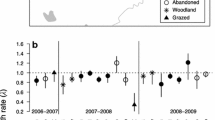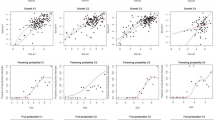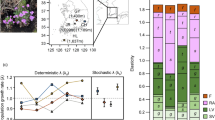Abstract
Remnant population dynamics permit many plant species to persist timespans extending from decades up to several millenia. The regional-scalepersistence of these plant species strictly depends on the persistence of localpopulations within the region. This type of dynamics can explain the existenceof preglacial relict species in the Mediterranean today. We studied thepopulation dynamics of the long-lived iteroparous herb Ramondamyconi, a preglacial relict species with a fragmented distributioninMediterranean mountains, to evaluate the regional-scale persistence of thespecies. Demographic data were collected from 5 populations placed at LaCerdanya Pyrenean region for up to 6 years. The main life-history features ofthis species are the great longevity of adult plants and the high mortality ofseedlings. Matrix population models were used to investigate its demography.Overall, the population growth rate (λ) ranged from a low of 0.79 to ahigh of 1.06. However, λ did not differ significantly from theequilibrium point, as indicated by their confidence intervals, except for onepopulation in one year. Despite the small between-year variation in λ,variation in climatic conditions at La Cerdanya from year to year explained animportant part of such variation. Elasticity analyses were performed toevaluatethe relative importance of demographic parameters for population growth. Stasistransitions made the greatest contribution to λ. Finally, the long-termdynamics of R. myconi populations were analysed byincorporating environmental stochasticity into the models. Projectionsindicatedthat local R. myconi populations tend to decline over timebut with a long time to extinction, so the persistence ofR. myconi all over La Cerdanya is determined by thepersistence of its remnant local populations.
Similar content being viewed by others
References
Alvarez-Buylla E.R. and Slatkin M. 1993. Finding confidence limits on population growth rates: Monte Carlo test of a simple analytic method. Oikos 68: 273–282.
Alvarez-Buylla E.R. and Slatkin M. 1994. Finding confidence limits on population growth rates: three real examples revised. Ecology 75: 255–260.
Bauert M.R., Kalin M., Baltisberger M. and Edwards P.J. 1998. No genetic variation detected within isolated relict populations of Saxifraga cernua in the Alps using RAPD markers. Molecular Ecology 7: 1519–1527.
Bengtsson K. 1993. Fumana procumbens on öland - population dynamics of a disjunt species at the northern limit of its range. Journal of Ecology 81: 745–758.
Bolòs O.de, Vigo J., Masalles R.M. and Ninot J.M. 1993. Flora Manual dels Països Catalans. Editorial Barcino, Barcelona.
Cardona M.A. and Contandriopoulos J. 1979. Endemism and evolution in the islands of the Western Mediterranean. In: Bramwell D. (ed.), Plants and Islands. Academic Press, London, pp. 133–169.
Castro J., Gómez J.M., García D., Zamora R. and Hódar J.A. 1999. Seed predation and dispersal in relict Scots pine forests in southern Spain. Plant Ecology 145: 115–123.
Caswell H. 1989. Matrix Population Models: Construction, Analysis, and Interpretation. Sinauer Associates, Sunderland.
Cox C.B. and Moore P.D. 1993. Biogeography: An Ecological and Evolutionary Approach. 5th edn. Blackwell Scientific, London.
Cohen J.E. 1986. Population forecast and confidence intervals for Sweden: a comparison of model-based and empirical approaches. Demography 23: 105–126.
Damman H. and Cain M.L. 1998. Population growth and viability analyses of the clonal woodland herb, Asarum canadense. Journal of Ecology 86: 13–26.
de Kroon H., Plaisier A., van Groenendael J. and Caswell H. 1986. Elasticity: the relative contribution of demographic parameters to population growth rate. Ecology 67: 1427–1431.
de Kroon H., van Groenendael J. and Ehrlén J. 2000. Elasticities: a review of methods and model limitations. Ecology 81: 607–618.
Dunnett N.P. and Willis A.J. 2000. Dynamics of Chamerion angustifolium in grassland vegetation over a thirty-nine-year period. Plant Ecology 148: 43–50.
Ehrlén J. 1995. Demography of the perennial herb Lathyrus vernus. II. Herbivory and population dynamics, Journal of Ecology 83: 297–308.
Eriksson O. 1996. Regional dynamics of plants: a review of evidence for remnant, source-sink and metapopulations. Oikos 77: 248–258.
Fiedler P.L., Knapp B.E. and Fredricks N. 1997. Rare plant demography: lessons from the Mariposa lilies (Calochortus: Liliaceae). In: Fiedler P.L. and Kareiva P.M. (eds), Conservation Biology: For the Coming Decade. Chapman & Hall, New York, pp. 28–48.
García D., Zamora R., Hódar J.A. and Gómez J.M. 1998. Age structure of Juniperus communis L. in the Iberian peninsula: Conservation of remnant populations in Mediterranean mountains. Biological Conservation 87: 215–220.
García D., Zamora R., Hódar J.A., Gómez J.M. and Castro J. 2000. Yew (Taxus baccata L.) regeneration is facilitated by fleshy-fruited shrubs in Mediterranean environments. Biological Conservation 95: 31–38.
Good R. 1964. The Geopraphy of Flowering Plants. Longmans, London.
Greuter W. 1994. Extinctions in Mediterranean Areas. Philosophical Transactions of the Royal Society of London 334: 41–46 Series B.
Heyde C.C. and Cohen J.E. 1985. Confidence intervals for demographic projections based on products of random matrices. Theoretical Population Biology 27: 120–153.
Horvitz C.C. and Schemske D.W. 1995. Spatiotemporal variation in demographic transitions of a tropical understory herb: projection matrix analysis. Ecological Monographs 65: 155–192.
Jónsdóttir I.S. 1991. Effects of grazing on tiller size and population dynamics in a clonal sedge (Carex bigelowii). Oikos 62: 177–188.
Lefkovitch L.P. 1965. The study of population growth in organisms grouped by stages. Biometrics 21: 1–18.
Menges E.S. 1992. Stochastic modeling of extinction populations. In: Fiedler P.L. and Jain S.K. (eds), Conservation Biology: The Theory and Practice of Nature Conservation Preservation and Management. Chapman and Hall, New York, pp. 253–275.
Menges E.S. 2000. Population viability analyses in plants: challenges and opportunities. Trends in Ecology and Evolution 15: 51–56.
Menges E.S. and Dolan R.W. 1998. Demographic variability of populations of Silene regia in midwestern prairies: relationships with fire management, genetic variation, geographic location, population, and isolation. Journal of Ecology 86: 63–78.
Moloney K.A. 1986. A generalized algorithm for determining category size. Oecologia 69: 176–180.
Moloney K.A. 1988. Fine-scale spatial and temporal variation in the demography of a perennial bunchgrass. Ecology 65: 1588–1598.
Müller J., Sprenger N., Bortlik K. and Boller T.A. 1997. Desiccation increases sucrose levels in Ramonda and Haberlea, two gerena of resurrection plants in the Gesneriacea. Physiologia Plantarum 100: 153–158.
Nantel P. and Gagnon D. 1999. Variability in the dynamics of the northern peripheral versus southern populations of two clonal plant species, Helianthus divaricatus and Rhus aromatica. Journal of Ecology 87: 748–760.
Nault A. and Gagnon D. 1993. Ramet demography of Allium tricoccum, a spring ephemeral, perennial forest herb. Journal of Ecology 81: 101–119.
Pavone L.V. and Reader R.J. 1985. Effect of microtopography on the survival and reproduction of Medicago lupilina. Journal of Ecology 73: 685–694.
Silvertown J., Franco M., Pisanty I. and Mendoza A. 1993. Comparative plant demography - relative importance of life-cycle components to the finite rate of increase in woody and herbaceous perennials. Journal of Ecology 81: 465–476.
Thompson J.D. 1999. Population differentiation in Mediterranean plants: insights into colonization history and the evolution and conservation of endemic species. Heredity 82: 229–236.
Tuljapurkar S.D. 1982. Population dynamics in variable environments. III. Evolutionary dynamics of r selection, Theoretical Population Biology 21: 141–165.
Author information
Authors and Affiliations
Rights and permissions
About this article
Cite this article
Xavier Picó, F., Riba, M. Regional-scale demography of Ramonda myconi: Remnant population dynamics in a preglacial relict species. Plant Ecology 161, 1–13 (2002). https://doi.org/10.1023/A:1020310609348
Issue Date:
DOI: https://doi.org/10.1023/A:1020310609348




